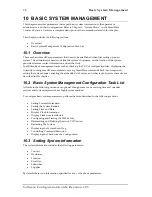
88
IP
Context
Overview
The most important difference between these types of devices is that the DCE device supplies the
clock signal that paces the communications on the interface.
Note:
The SmartNode 2300 is working as a DTE per default.
Before you connect a device to the synchronous serial port, labelled SERIAL 0/0 on SmartNode 2300,
you need to check the following:
•
Confirm that the device you are connecting to is a DCE providing a clock signal on the
synchronous serial interface.
•
Type of connector, male or female, required connecting at the device
•
Signalling protocol required by the device must be X.21 or V.35
11.3.3 QoS Related Information
Check with your access service provider if there are any QoS related requirements, which you need
to know prior to configuring SmartWare QoS management. Check the following with your access
service provider:
•
What is the dedicated bandwidth, which you have agreed with your access service provider?
•
How does your provider perform packet classification, e.g. which ToS bits have to be used to
define the supported classes of service?
11.4 Configuring Ethernet and Serial Ports
In SmartWare Ethernet and serial ports represent the physical connectors on the SmartNode
hardware. Since ports are closely-knit with the physical structure of a SmartNode, they cannot be
created but have to be configured. The configuration of a port includes parameters for the physical
and data link layer such as framing and encapsulation formats or media access control. Before any
higher-layer user data can flow through a physical port, you must associate that port with an
interface within the IP context. This association is referred to as a
binding
.
For information and examples on how to configure an Ethernet port refer to Chapter 14, “Ethernet
Port Configuration” or for a serial port to Chapter 16, “Serial Port Configuration” later in this user
guide.
11.5 Creating and Configuring IP Interfaces
Today SmartWare supports one instance of the IP context, named “router”. The number and names
of IP interfaces depend upon your application scenario. In SmartWare, an interface is a logical
construct that provides higher-layer protocol and service information, such as layer 3 addressing.
Hence interfaces are configured as part of IP context and represent logical entities that are only
usable if a physical port is bound to them.
An interface name can be any arbitrary string, but for ease of identification self-explanatory names
should be used which depict the use of the interface. An example is using names like “lan” for an IP
interface that connects to the LAN and “wan” for an interface that connects to the access network or
WAN. Avoid names that represent the nature of the underlying physical port for logical interfaces,
like “eth0” or “serial0”, to represent Ethernet port 0 or serial port 0, since IP interfaces are not strictly
bound to a certain physical port. During the operation of a SmartNode it is possible to move an IP
interface to another physical port, e.g. from an Ethernet to a serial port. For that reason it would be
more than misleading, if an interface holds a name like “eth0”, but actuality is assigned to a serial
Software Configuration Guide, Revision 1.03
















































